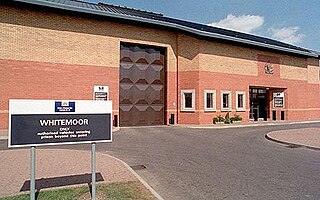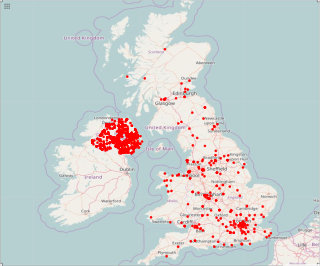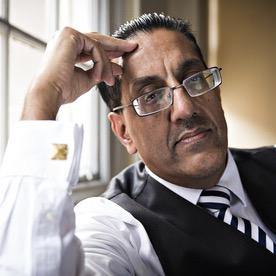Demographics
People from ethnic minority backgrounds
According to House of Commons research, people of minority ethnicities (BAME) constitute 13% of the general population, but make up 27% of the prison population. [1] In 2017, a review led by David Lammy MP concluded that the justice system was biased against this group, and required reform. [5] In 2019, Lammy expressed deep concern at the high proportion of BAME males in young offender institutions with 51% of boys in young offender institutions identifying as BAME, saying that "England and Wales are now hitting an American scale of disproportionality in our youth justice system". [6] The over-representation of the black population in prisons may be a result of stop and search, custodial remands and the make-up of the prison population itself with 32% of all children in prison being black. [7]
| Position | Ethnic group | Prison population | Per cent of incarcerated population | Per cent of population (2021 Census)‡ [9] |
|---|---|---|---|---|
| 1 | White | 63,103 | 71.8% | 81.7% |
| 2 | Black or Black British | 10,624 | 12.1% | 4.0% |
| 3 | Asian or Asian British | 7,067 | 8.0% | 9.3% |
| 4 | Mixed | 4,188 | 4.8% | 2.9% |
| 5 | Other ethnic group | 1,794 | 2.0% | 2.1% |
| Unrecorded / Non stated | 1,093 | 1.2% | — | |
| Total (2024) | 87,869 | 100% | 100% | |
Notes:
‡ 2021 Census, England and Wales only
Religious group
In the two decades since 2002, the proportion of Christian prisoners has fallen, by 14%, to 44% of the incarcerated population meanwhile the proportion of Muslim prisoners has risen, by 10%, to 18%. Other religious groups did not see a significant change in proportion. [1] Beginning in 2008, concerns over the spread of Sharia in British prisons, including the operation of Sharia courts and the forced conversions of non-muslims, have been reported. [10] [11] [12] [13] According to the UK prison officers' union in 2013, some Muslim prisoners in the UK had allegedly forcibly converted fellow inmates to Islam in prisons. [14] There have been multiple cases of non-muslim prisoners threatened with violence [15] with "convert or get hurt" being a commonly used phrase by Muslim gangs according to an independent report published by the government. [16] In category A and B prisons, former inmates have publicly spoken out on the rise of Islamism with the "balance of power" in reputational violence now shifted towards Muslim gangs. [17] Other reasons why inmates may convert include wanting protection in wings where Muslim gangs are prevalent, the ability to go to chapel, and access to different foods. Around 1 in 5 Muslim prisoners in the UK are now white. [18]
The Fishmonger's Hall, Streatham, and Reading attacks brought increased attention on the risk of Islamist gangs and convicted terrorists radicalising other inmates in prisons. [19] [20] Concerns were first raised in 2010 by the Royal United Services Institute over the growing radicalisation of Muslims in prisons. [21] According to Jonathan Hall KC, the Independent Reviewer of Terrorism Legislation, convicted terrorists "enjoy high status" in prisons and other inmates are attracted to their extremist interpretation of Islam. [22] [23] The 2023 CONTEST report found that Islamic terrorists represented 64% of those in custody for terrorism-connected offences with 44% of declared terrorist attacks in the UK since 2018 perpetrated by serving or recently released Muslim prisoners. [24] Attempts to engage imprisoned terrorists with de-radicalisation programmes have been largely unsuccessful. [25]
| Position | Religious group | Prison population | Per cent of incarcerated population | Per cent of population (2021 Census)‡ [27] |
|---|---|---|---|---|
| 1 | Christianity | 39,068 | 44.5% | 46.2% |
| 2 | No religion | 27,122 | 30.9% | 37.2% |
| 3 | Islam | 15,909 | 18.1% | 6.5% |
| 4 | Other religious group | 2,335 | 2.7% | 0.6% |
| 5 | Buddhism | 1,656 | 1.9% | 0.5% |
| 6 | Sikhism | 578 | 0.7% | 0.9% |
| 7 | Judaism | 511 | 0.6% | 0.5% |
| 8 | Hinduism | 348 | 0.4% | 1.7% |
| Not recorded | 335 | 0.4% | 6.0% | |
| Non recognised | 7 | 0.0% | — | |
| Total (2024) | 87,869 | 100% | 100% | |
Notes:
‡ 2021 Census, England and Wales only
Immigrants and foreign nationals
76,869 British nationals were recorded in the prison population at the end of the first quarter of 2024. The remainder of the population was made up of 10,422 foreign nationals, making up 11.9% of the total population, with an additional 578 having no nationality recorded. [28]
| Position | Nationality status | Prison population | Per cent of Total |
|---|---|---|---|
| 1 | | 1,273 | 12.2% |
| 2 | | 906 | 8.7% |
| 3 | | 750 | 7.2% |
| 4 | | 649 | 6.2% |
| 5 | | 381 | 3.7% |
| 6 | | 361 | 3.5% |
| 7 | | 313 | 3.0% |
| 8 | | 290 | 2.8% |
| 9 | | 271 | 2.6% |
| 10 | | 259 | 2.5% |
| 11 | | 250 | 2.4% |
| 12 | | 248 | 2.4% |
| 13 | | 233 | 2.2% |
| 14 | | 172 | 1.7% |
| 15 | | 167 | 1.6% |
| All other nationalities | 3,899 | 37.4% | |
| Total (2024) | 10,422 | 100% | |
Notes: Data for England and Wales only
Age group
| Position | Age group | Prison population | Per cent of Total |
|---|---|---|---|
| 1 | 30–39 | 29,339 | 33.4% |
| 2 | 40–49 | 18,175 | 20.7% |
| 3 | 25–29 | 13,226 | 15.1% |
| 4 | 50–59 | 9,391 | 10.7% |
| 5 | 21–24 | 8,155 | 9.3% |
| 6 | 60–69 | 4,250 | 4.8% |
| 7 | 18–20 | 3,090 | 3.5% |
| 8 | 70 and over | 1,979 | 2.3% |
| 9 | 15–17 | 264 | 0.3% |
| Total (2024) | 87,869 | 100% | |
Notes: Data for England and Wales only
Children and young people aged under 18 are not sent to adult prisons if they are sentenced to custody. [30] They either go to young offender institutions (for prisoners aged 15–21), secure training centres (for those aged under 17) or secure children's homes (for those aged under 15). [30]
The number of children in custody has declined since mid-2008, from more than 3,000 to about 900 at any one time. [31] In 2019 an independent inquiry into child sexual abuse published a report that described the scale of alleged abuse in young offender institutions and secure training centres as “shockingly high”. [31]
The number of British prisoners over 60 years of age rose by 130% between 2002 and 2013, a shift attributed to an increase in the convictions for historic sex abuse. The increase was reported after the 2012 commencement of Operation Yewtree, a police investigation into sexual abuse allegations—predominantly the abuse of children—against the British media personality Jimmy Savile and others. [32] In relation to over 4,000 over-60 prisoners in UK prisons, Professor David Wilson of Birmingham City University stated in July 2014:
Four out of 10 of these prisoners (the over-60s) were convicted of sex offences and people over 60 are the fastest growing age group in the prison estate, yet there is no national strategy for the elderly who get sent to prison ... The Prison Service needs to develop a strategy to cope with this fastest growing section of the prison population or they will simply be failing in their duty of care to the elderly people that they are locking up. [32]
In 2018 there were more than 1,500 prisoners over 70, including more than 200 aged over 80, creating increasing demands on health and social care systems. [33]
Gender
3,635 women were recorded in the prison population (4.1%) at the end of the first quarter of 2024. [4] As of 2018, most were serving time for non-violent offences. [34] There is evidence that women may be a particularly vulnerable prison population: they account for 20% of self-injury behind bars, and are twice as likely to report mental health issues as male prisoners. [35] In 2018 the government launched a new Female Offender Strategy to try and address the needs of this particular population. [34]
Women with a child aged under 18 months old may apply to bring their child into prison with them, if they are serving a short sentence. [36] Women who give birth in prison may keep their baby for the first 18 months in a mother and baby unit. [36]












